Fujitsu is providing 4Mbit Quad SPI FeRAM capable of 54MB/s data transfer
Non-volatile memory with a high operational speed that contributes to improving the performance of networking devices
Overview
We are mass-producing the 4Mbit FeRAM MB85RQ4ML featuring fast data transfer. This non-volatile memory can achieve data transfer rate of 54MByte per second at maximum 108MHz of operating frequency and a Quad SPI interface with four I/O pins. (Fig.1)
With features of high-speed operation and non-volatility, this product makes it ideal for use in the industrial computing and networking devices such as programmable logic controllers(PLCs) and routers requiring fast data rewriting. (Fig.2)
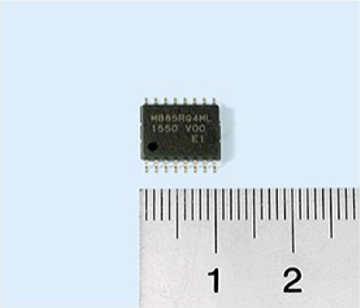 Fig.1: MB85RQ4ML Package
Fig.1: MB85RQ4ML Package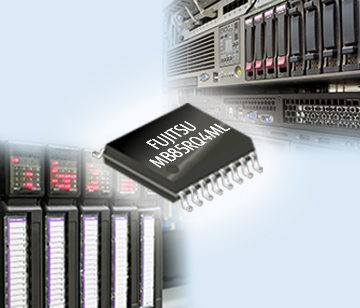 Fig.2: Suitable Usage (PLC, Router)
Fig.2: Suitable Usage (PLC, Router)Details
For over 20 years, we have mass-produced FeRAM products featuring higher read/write endurance, faster writing speed operation and lower power consumption compared to EEPROM and flash memory. So far these high reliable products have been successfully adopted in industrial, infrastructure, consumer, and automotive fields.
In addition, some customers have been requesting for FeRAM that can operate with fast data transfer while being non-volatile memory. We were pleased to be able to fulfill this requirement with the Quad SPI 4Mbit FeRAM product.
This product adopts a Quad SPI interface and 1.8V power supply voltage and it is capable data transfer rate of 54MB/s at operating frequency of 108MHz. Until the release of this product, 4Mbit FeRAM with parallel interface of 16 I/O pins is the fastest FeRAM having 13MB/s data transfer.
However, the MB85RQ4ML with only four I/O pins enables to read and write the data in about 4 times of that of parallel interface FeRAM. (Fig.3) Its package is 16pin SOP in 7.5mm x 10.3mm package size.
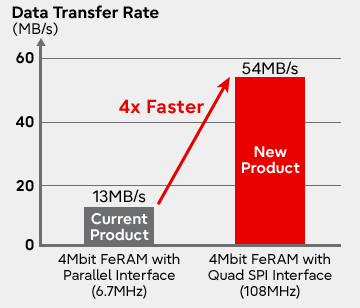 Fig.3: Data Transfer Rate Comparison
Fig.3: Data Transfer Rate Comparison
Customer Issues and Solution by FeRAM
If you are using Flash memory, EEPROM, or low power SRAM in your products and have any of the following issues, please consider our FeRAM for your solutions.
1) Status: Using Flash memory
Issue: Large software development burden due to lower write endurance
Flash memory guarantees a few 100K times of write cycles. If data are written to the same area in the memory many times, the area reaches to an upper limit of guaranteed write cycle time soon.
Therefore, design engineers have to develop the software called “wear leveling” to distribute the write locations in memory area so that the data are not written to the same location many times.
The workload for development of the software is a very large burden for design engineers.
While FeRAM guarantees 10 trillion of read/write cycles and data can be over-write to memory area like low power SRAM. The features help design engineers because the engineers don't need to develop complicated software for data writing such as wear leveling. (Fig.4)
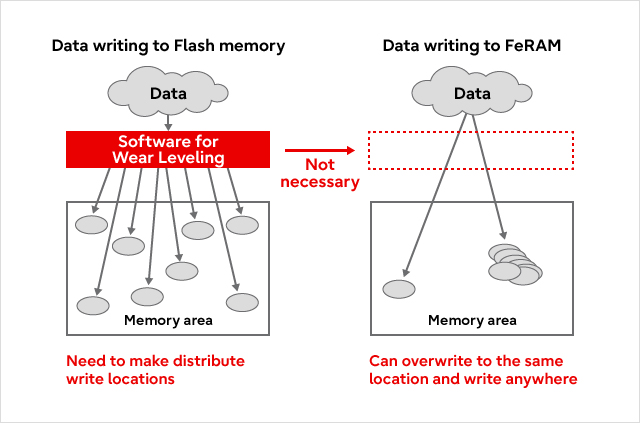
Fig.4: Diagram of Wear Leveling
2) Status: Using EEPROM
Issue: Data write time is longer
EEPROM has 5ms of write cycle time for even 8-bit data writing because it includes the erase operation in addition to write operation. On the other hand, FeRAM has shorter write time such as several hundreds of ns at 8-bit data writing because it doesn’t need the erase operation. (Fig.5)
Besides, EEPROM with SPI interface has 2.5Mbyte/s of data transfer rate at maximum 20MHz of operating frequency. While, our Quad SPI FeRAM has 54Mbyte/s that is more than 20 times of EEPROM’s one.
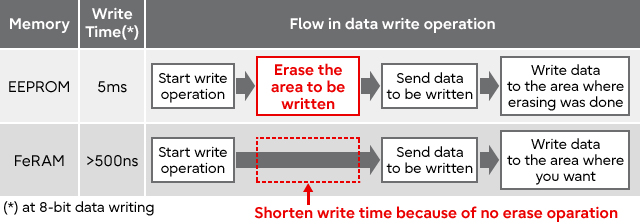
Fig.5: Write Time Comparison
3) Status: Using SRAM
Issue: Difficult to remove a battery and to reduce component mounting area
Low power SRAM needs a battery for data retention to keep written data, but FeRAM doesn’t need the battery due to non-volatile memory. Then, many SRAMs are in the form of 44pin TSOP package because SRAM has 16 I/O pins, but the MB85RQ4ML are in 16pin SOP package with 4 I/O pins.
This means, if you replace the SRAM with FeRAM, you can reduce 77% of mounting area for memory by removing a battery and using smaller package. (Fig.6)
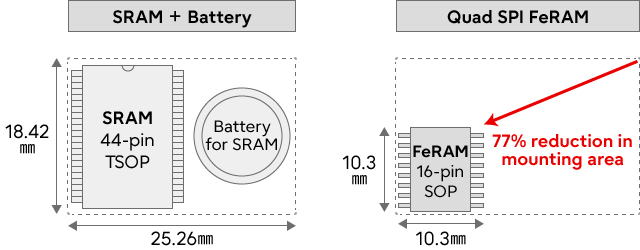
Fig.6: Memory Mounting Area Comparison
In summary, if you have any issues using conventional memory devices in your products, you can expect some merits such as reducing costs, shorten development period, enhancing product performance, and smaller products by using FeRAM device. (Fig.7)
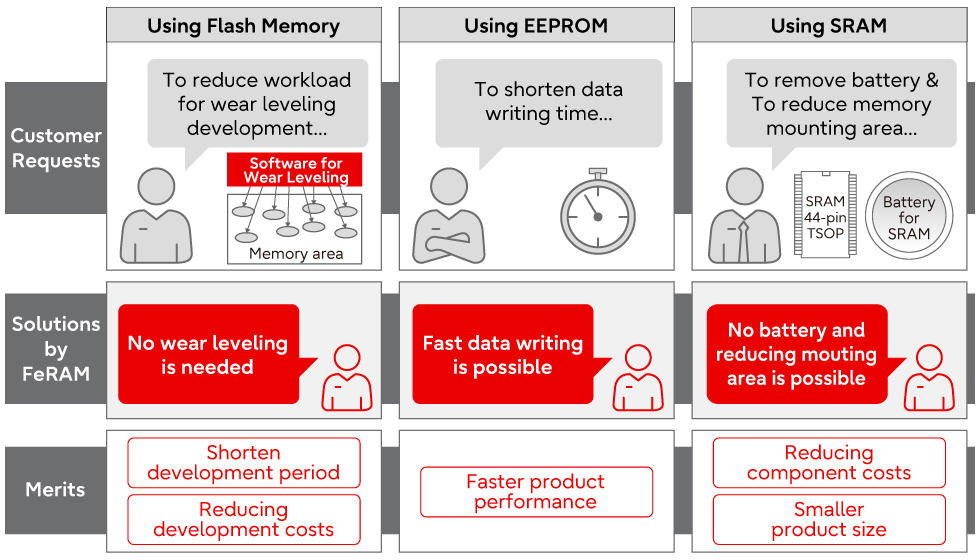
Fig.7: Customer Requests and Solutions by FeRAM
Our Message
In the IoT market, which deals with big data, the amount of data processing is increasing, and the memory used for networking devices requires frequent data rewriting. The MB85RQ4ML featuring 10 trillion times of read/write endurance and high-speed operation is an ideal memory for networking devices such as PLCs and routers that require continuous rewriting of setting data.
The MB85RQ4ML is a 4Mbit FeRAM product, and we are developing another larger density product with a Quad SPI interface. If you are interested in the large density product, please ask us with the following inquiry form.
We continue to develop new memory products required in that era.
Key Specifications
| Part number | MB85RQ4ML |
|---|---|
| Density (configuration) | 4Mbit (512K x 8bit) |
| Interface | SPI / Quad SPI |
| Power supply voltage | 1.7V to 1.95V |
| Operating frequency | maximum 108MHz |
| Guaranteed read/write cycles | 10 trillion times |
| Data retention | 10 years (at +85℃) |
| Package | 16pin SOP |
Related Links
 Inquiry
Inquiry
For requests of evaluation samples, datasheets, brochures, simulation models, and/or any documents
For technical questions or general questions such as product availability, pricing, etc.
Please refer to FeRAM's FAQ when you have questions about FeRAM.
Our inquiry forms support SSL-secure encryption with SSL certificates for identity verification and privacy protection.
Site Map
-
Product Lineup
-
Contents on FeRAM
